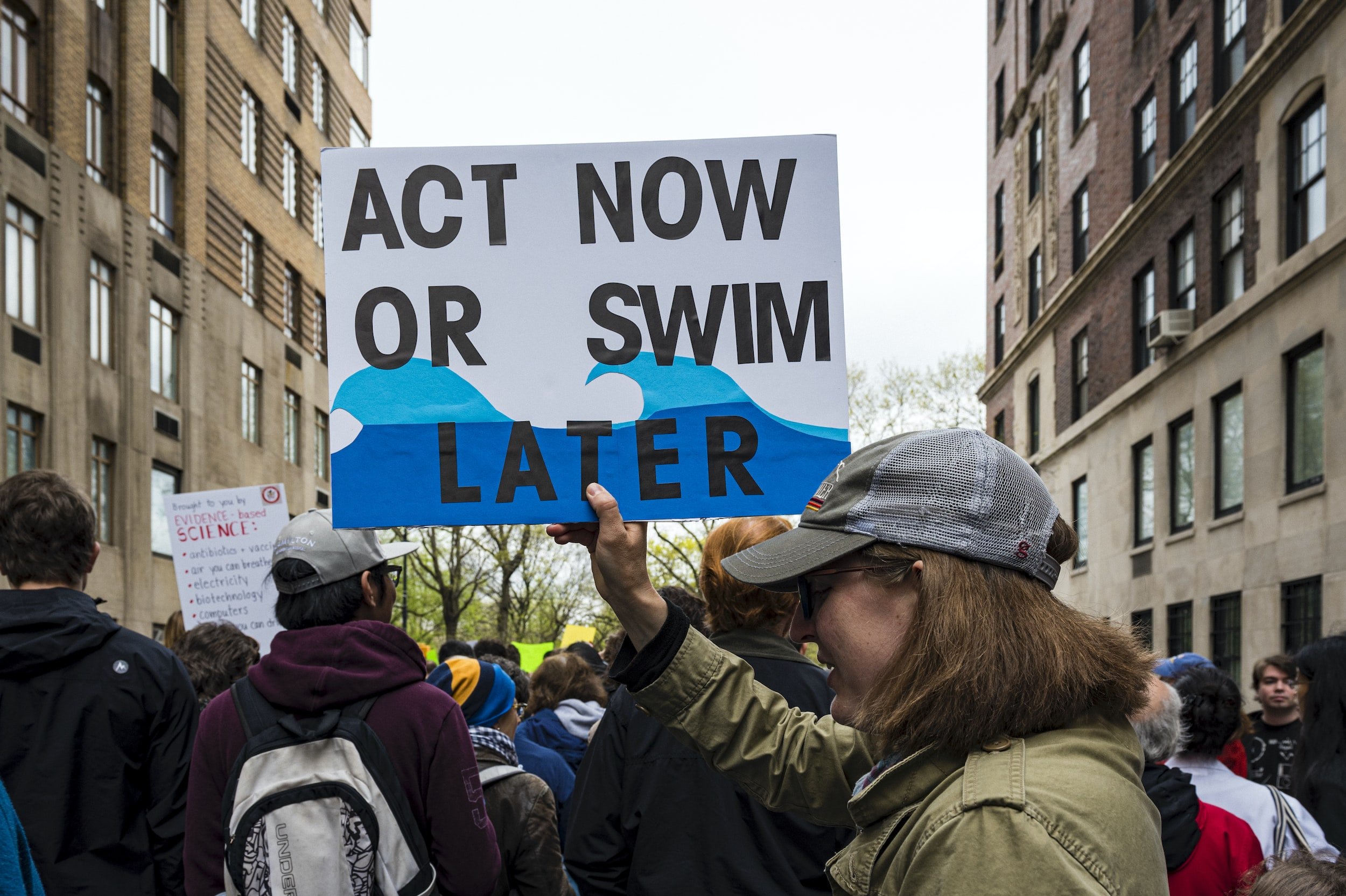
Green Dreams, Concrete Realities
With the coming of a second Trump administration, local action on climate change will be vital for making progress towards both mitigation and adaptation goals. One under-appreciated potential engine for this progress are mid-sized U.S. cities, which fall between the large cities (New York, LA), whose climate plans dominate the news and the small rural communities that are the focus of much of existing research on the green transition. Over the last two years, I’ve focused on the factors that shape climate policy outcomes in mid-sized cities and what they can teach us about local climate policy more broadly.

What Drives Adaptation?
While coastal local governments are accustomed to managing disruptions and uncertainty, they will face a pronounced challenge from sea level rise (SLR). SLR has the potential to reshape coastal communities through enhanced coastal flooding, saltwater intrusion, and the eventual loss of habitable land. In the long term, SLR could lead to migration away from low-lying coastal areas, reductions of tax revenue, demand for new infrastructure, and costly damages from extreme weather events, but even today recurrent high tide flooding is already delaying commuters in coastal areas.

High and Dry
Recent hurricanes, floods, and wildfires across the United States highlight the devastating effect of climate change on individuals and households. Renters and households with low incomes are disproportionately exposed to and harmed by these disasters in many ways – but there are still open questions about the effects of these disasters, specifically on rents. On the one hand, disasters often lead people to leave affected areas, which may lessen demand for housing and lead to lower rents. On the other hand, disasters generally damage housing units, rendering some unusable, which may lower supply and lead to higher rents.

Creating Local “Citizen’s Governance Spaces” in Austerity Contexts
In many cities, and particularly in a context of neoliberal austerity and governmental withdrawal from public action, citizens act upon their urban environment. If these initiatives could be presented as spaces of resistance to neoliberalism, or as political acts of reclaiming the city, these emergent practices are neither a manifestation of state retrenchment nor its outright rejection. Individuals and loosely organized collectives involved in such initiatives develop and are embedded in complex and multidimensional relationships with local institutions and third sector organizations. Montreal is a particularly interesting case to observe these practices. Bringing citizens’ initiatives and so-called social innovations to the core of public action have been among the neoliberal policy orientations pursued by some of Montreal’s boroughs and third sector organizations, increasingly relying on volunteers and private citizens to intervene in the public sphere, especially in the areas of urban gardening and food recuperation.

Toward a state-led, market-enabled commons
What is community energy? What does green energy have anything to do with local places, democracy and common goods? How do lay people contribute to the production and the distribution of solar energy? These may be some usual questions coming to people’s minds whenever group solar or collective power campaigns pop up on the press or in the forums. Community energy is a type of community-owned, -financed, and -operated renewable energy supply in the form of a project or program initiated by a group of people united by a place, a neighborhood, and/or a set of common interests.

The Emergence of Environmental Justice in General Plans
Urban planning has an uneasy relationship with environmental justice. Poor planning decisions and discriminatory practices have historically heightened the burdens of environmental contamination in low-income neighborhoods and communities of color, in comparison to white, wealthy populations. Since the 1980s, activists have garnered some regulatory and scholarly support for changes to policy and planning processes, but urban planners have been slow to adopt an explicit EJ framework in land use policies. The planning profession, however, has the capacity to help ensure that future development does not repeat the unjust environmental outcomes of the past.

Water Utility Districts as Facilitators of Regional Climate Change Partnerships
Unlike much of the literature on regional activity that centers on how general-purpose local governments choose to respond to externalities or other cross-boundary drivers, Jayce Farmer (University of Nevada-Las Vegas) centers existing water utility districts as the key independent variable.

Walking the Talk
Why do some municipalities adopt ambitious climate action plans and others do not? How can we encourage more cities to be ambitious? The Intergovernmental Panel on Climate Change (IPCC) has warned that CO2 emissions must reach net zero by 2050 to prevent the most devastating consequences of global climate change. Cities consume more than two-third of the world’s energy, emit more than seventy percent of the global CO2 emissions, and contain 55% of the world’s population, so their efforts will be critical to our ability to prevent catastrophic combat climate change.

Characterizing the Non-linear Relationship Between Capacity and Collaboration in Urban Energy and Climate Initiatives
In the wake of the United States’ initiation of its formal withdrawal from the Paris Climate Agreement, the continued commitment of city governments is serving, for some, as a beacon of hope. However, although there are many examples of cities achieving significant reductions in their greenhouse gas emissions, individual local governments cannot generate the necessary scale of changes alone. The emphasis that both scholarly and practitioner-focused studies place on understanding the dynamics that facilitate successful inter-jurisdictional and inter-organizational collaborations around local climate and energy objectives reflect this recognition.

From Progressive Cities to Resilient Cities
Advocates for a Green New Deal forcibly argue that climate action must be racially just and transform institutions that govern social welfare. However, these proposals have focused on cutting carbon emissions and been vague on how the country should adapt to an already changing climate. Early proposals suggest that a Green New Deal for adaptation should emphasize large-scale investments in infrastructure for marginalized communities. But evidence suggests that adaptation infrastructure projects can worsen the well-being of the most vulnerable. For instance, cities tend to prioritize investments for high value real estate or enforce land use and other regulations more stringently on those with less political voice. There also isn’t enough money to protect everyone and every place. Given the prevailing dynamics of urban development, an adaptation moon-shot must go far beyond giving the poor a sea wall or sand dune.

Public Housing Participation in Superstorm Sandy Recovery
In February in New York City, the Citywide Council of Presidents, an elected body representing over 400,000 tenants of the New York City Housing Authority (NYCHA), took the unprecedented step of suing the agency. Resident leaders sought an independent monitor for the Authority, pointing to high-profile health and safety failures including a lapse in lead paint inspections with fraudulent reports to the contrary from the Chairwoman, Shola Olatoye, and sporadic heat and hot water during a frigid winter.

Hurricanes, Climate Change, and Urban Growth Machines
During this latest and most brutal of hurricane seasons, the real estate website Zillow.com offered that hurricanes typically had no impact on property values in the coastal areas most often impacted by such storms. Yet the website also cautioned that “Whether or not this holds true in the wake of Harvey and Irma remains to be seen.” Indeed, what ostensibly might affect coastal property values is not hurricanes per se, but rather the fact that increasingly severe storms are just one of the more obvious facets of the multiple impacts climate change will have on coastal communities.

How Cities Are Promoting Clean Energy and Dealing with Problems Along the Way
Cities are taking the initiative to promote environmental sustainability. They provide incentives for buildings and homes to go green. They adhere to smart growth. They design urban space in a way that facilitates the interactions of human, nature, and built environment. And their latest efforts are directed toward clean energy. Many cities are not only encouraging residents to use but also produce their own electricity through renewable sources. But the road to clean energy is not a straight path. It has twists and turns and many obstacles along the way.

The Politics of Urban Climate Change
Cities are becoming an important focal point for climate change policy: they are responsible for a large portion of energy-related greenhouse gas (GHG) emissions, and have shown tremendous leadership in committing to GHG emissions reductions, even as many national governments fail to do so. Indeed, Scientific American recently claimed that, “Climate Change Will be Solved in Cities – Or Not at All” and more than one thousand city leaders attended the recent international climate change negotiations in Paris.